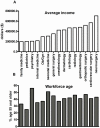The Addiction Psychiatrist as Dual Diagnosis Physician: A Profession in Great Need and Greatly Needed
- PMID: 24223531
- PMCID: PMC3819106
- DOI: 10.1080/15504263.2013.807072
The Addiction Psychiatrist as Dual Diagnosis Physician: A Profession in Great Need and Greatly Needed
Abstract
Addiction is the number one cause of premature illness and death in the U.S., especially among people with mental illness. Yet American medicine lacks sufficient workforce capacity, expertise, training, infrastructure, and research to support treatment for people with co-occurring addictions and mental illness. This essay argues that the addiction psychiatrist is essential in dual diagnosis care.
Keywords: addiction psychiatry; physician workforce shortages; public health crisis.
Figures


Similar articles
-
The Dual Diagnosis Physician-infrastructure Assessment Tool: examining physician attributes and dual diagnosis capacity.Psychiatr Serv. 2010 Feb;61(2):184-8. doi: 10.1176/ps.2010.61.2.184. Psychiatr Serv. 2010. PMID: 20123825 Free PMC article.
-
Training the next generation of providers in addiction medicine.Psychiatr Clin North Am. 2012 Jun;35(2):461-80. doi: 10.1016/j.psc.2012.04.001. Psychiatr Clin North Am. 2012. PMID: 22640766
-
Projected Workforce of Psychiatrists in the United States: A Population Analysis.Psychiatr Serv. 2018 Jun 1;69(6):710-713. doi: 10.1176/appi.ps.201700344. Epub 2018 Mar 15. Psychiatr Serv. 2018. PMID: 29540118
-
Addiction Psychiatry and Addiction Medicine: The Evolution of Addiction Physician Specialists.Am J Addict. 2020 Sep;29(5):390-400. doi: 10.1111/ajad.13068. Am J Addict. 2020. PMID: 32902056 Review.
-
Precision Psychiatry and Dual Disorders.J Dual Diagn. 2018 Oct-Dec;14(4):237-246. doi: 10.1080/15504263.2018.1512727. Epub 2019 Jan 14. J Dual Diagn. 2018. PMID: 30638153 Review.
Cited by
-
The Penrose Effect and its acceleration by the war on drugs: a crisis of untranslated neuroscience and untreated addiction and mental illness.Transl Psychiatry. 2019 Nov 28;9(1):320. doi: 10.1038/s41398-019-0661-9. Transl Psychiatry. 2019. PMID: 31780638 Free PMC article. Review.
-
Prescription drug monitoring program inquiry in psychiatric assessment: detection of high rates of opioid prescribing to a dual diagnosis population.J Clin Psychiatry. 2014 Jul;75(7):750-6. doi: 10.4088/JCP.14m09020. J Clin Psychiatry. 2014. PMID: 25093472 Free PMC article.
-
The Clinical Concept of Opioid Addiction Since 1877: Still Wanting After All These Years.Front Psychiatry. 2018 Oct 16;9:508. doi: 10.3389/fpsyt.2018.00508. eCollection 2018. Front Psychiatry. 2018. PMID: 30386269 Free PMC article.
-
Growing the Psychiatry Workforce Through Expansion or Creation of Residencies and Fellowships: the Results of a Survey by the AADPRT Workforce Task Force.Acad Psychiatry. 2022 Aug;46(4):421-427. doi: 10.1007/s40596-021-01509-9. Epub 2021 Jul 22. Acad Psychiatry. 2022. PMID: 34292538 Free PMC article.
-
Case Report: Internet Gaming Disorder Associated With Pornography Use.Yale J Biol Med. 2015 Sep 3;88(3):319-24. eCollection 2015 Sep. Yale J Biol Med. 2015. PMID: 26339216 Free PMC article.
References
-
- Altman DE, Fineberg HV, Gold MS, Greenfield SF, Kabler ER, Lynk M, Sullivan LW. Addiction medicine: Closing the gap between science and practice. The National Center on Addiction and Substance Abuse at Columbia University; New York, NY: 2012. Retrieved from http://www.casacolumbia.org/upload/2012/20120626addictionmed.pdf.
-
- Becker WC, Fiellin DA, Gallagher RM, Barth KS, Ross JT, Oslin DW. The association between chronic pain and prescription drug abuse in Veterans. Pain Medicine. 2009;10(3):531–536. - PubMed
-
- Bohnert AS, Ilgen MA, Ignacio RV, McCarthy JF, Valenstein M, Blow FC. Risk of death from accidental overdose associated with psychiatric and substance use disorders. American Journal of Psychiatry. 2012;169(1):64–70. doi: 10.1176/appi.ajp.2011.10101476appi.ajp.2011.1010147. - PubMed
-
- Boscarino JA, Rukstalis M, Hoffman SN, Han JJ, Erlich PM, Gerhard GS, Stewart WF. Risk factors for drug dependence among out-patients on opioid therapy in a large US health-care system. Addiction. 2010;105(10):1776–1782. doi: 10.1111/j.1360-0443.2010.03052.x ADD3052. - PubMed
-
- CDC Vital Signs: Overdoses of prescription opioid pain relievers United States, 1999-2008. Montly Morbidity and Mortality Report. 2011;60(43):1487–1492. - PubMed
Grants and funding
LinkOut - more resources
Full Text Sources
Other Literature Sources
